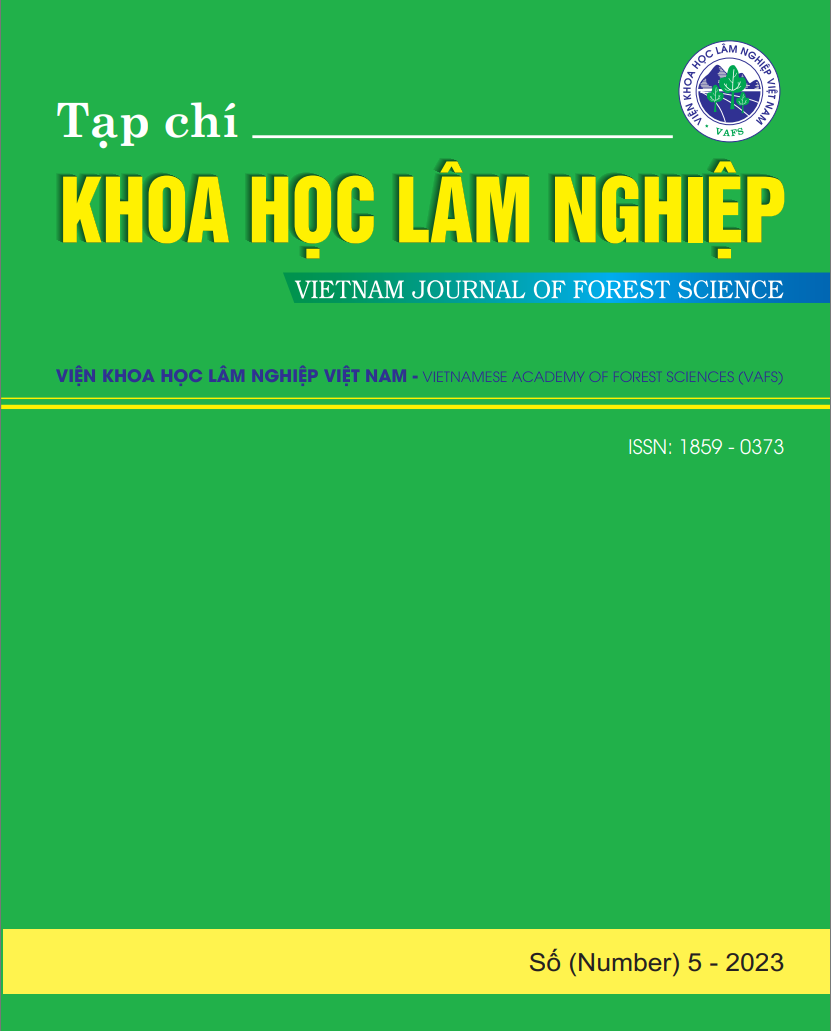STUDY ON THE EFFECTS OF PRESSING TIME AND ADHESIVE TYPE ON THE PROPERTIES OF C-SHAPED MOLDED WOOD COMPONENTS
DOI:
https://doi.org/10.70169/VJFS.1139Keywords:
Structural lumber, physico-mechanical properties, Acacia mangium, adhensive, forming pressAbstract
In this article, the effects of pressing time and adhesive type on the properties of Acacia mangium veneer - based composite (VCB) was investigated. The results indicated that both pressing time and adhesive type significantly influenced the physical and mechanical properties of the VCB. Pressing time was found to be a critical factor for bonding performance. As for Phenol-resorcinol-formaldehyde (PRF) adhesive, the optimal pressing time was 12 hours (comprising 5 hours of cold molding press and 7 hours of clamping during assembly). Meanwhile, Emulsion polymer isocyanate (EPI) adhesive required a total of 10 hours (5 hours of cold pressing and 5 hours clamping). There was a clear distinction between the properties of components bonded with PRF and those bonded with EPI, reflecting the different bonding mechanisms. Overall, the VCB bonded with PRF showed 20 - 30% higher than EPI in terms of strength and dimensional stability. According to the Vietnamese standard TCVN 12619 - 2:2019, PRF-bonded components met the requirements equivalent to group III of solid wood. Delamination and glue line assessments further confirmed the superior moisture and weather resistance of PRF - bonded assemblies. These findings provide a scientific foundation for the development of large-sized structural wood components, such as I-beams and hollow box sections, based on C-shaped modular elements, thereby enhancing the application potential in construction and furniture manufacturing using plantation wood.
References
1. Berard P, Yang P, Yamauchi H, Umemura K, Kawai S, 2011. Modeling of a cylindrical laminated veneer lumber II: A nonlinear finite element model to improve the quality of the butt joint. Journal of Wood Science, Vol. 57, Issue 2, pp 107–113. DOI: 10.1007/s10086-010-1148-8
2. Gilbert BP, Underhill ID, Bailleres H, Hanandeh E, McGavin RL, 2014. Veneer based composite hollow utility poles manufactured from hardwood plantation thinned trees. In Construction and Building Materials, Vol. 66, pp 458 - 466. DOI: 10.1016/j.conbuildmat.2014.05.093
3. Gilbert BP, Underhill ID, Fernando D, Bailleres H, 2017. Structural solutions to produce long timber Veneer Based Composite hollow sections. In Construction and Building Materials, Vol. 139, pp 81–92. DOI: 10.1016/j.conbuildmat.2017.02.046
4. Gilbert BP, Underhill ID, Fernando D, Bailleres H, Miller D, 2018. Structural behaviour of hardwood veneer-based circular hollow sections of different compactness. In Construction and Building Materials, Vol. 170, pp 557 - 569. DOI: 10.1016/j.conbuildmat.2018.03.105
5. Gilbert B, Lebée A, Foret G, 2020. Veneer-based timber circular hollow section beams: Behaviour, modelling and design. Construction and Building Materials, pp. 1 - 14. DOI: 10.1016/j.conbuildmat.2020.120380
6. Grabner M, Wolf A, Schwabl E, Schickhofer G, 2016. Methods of forming veneer structures. In WCTE 2016 e-book -World Conference on Timber Engineering, pp 849 - 858. http://wcte2016.conf.tuwien.ac.at/home/
7. Hata T, Umemura K, Yamauchi H, Nakayama A, Kawai S, Sasaki H, 2001. Design and pilot production of a “spiral-winder” for the manufacture of cylindrical laminated veneer lumber. Journal of Wood Science, Vol. 47, Issue 2, pp 115 - 123. DOI: 10.1007/BF00780559
8. Hirschmüller S, Marte R, Englberger A, 2019. Laminated veneer lumber hollow cross-sections for temporary soil nailing. Proceeding of International Scientific Conference on Hardwood Processing, 2019, pp 71 - 84. https://resolver.tudelft.nl/uuid:3032cdf9-9e7e-48bd-be81-ce2db7dbb0f1
9. Hirschmüller S, Pravida J, Marte R, Flac M, 2019. Long term material properties of circular hollow laminated veneer lumber sections under water saturation and cement alkaline attack. Wood Material Science & Engineering, pp. 142 - 156. DOI: 10.1080/17480272.2018.1434830
10. Nguyễn Quang Trung, 2012. Nghiên cứu xử lý một số loại gỗ rừng trồng từ nhóm 5 đến nhóm 8 làm nguyên liệu đóng tàu thuyền đi biển. Báo cáo tổng kết đề tài cấp Bộ Nông nghiệp và PTNT.
11. Nguyễn Quang Trung. 2019. Nghiên cứu công nghệ sản xuất gỗ khối (Multilaminar Block) chất lượng cao từ gỗ keo. Báo cáo tổng kết đề tài cấp Bộ Nông nghiệp và PTNT.
12. Nguyễn Trọng Kiên, Phạm Văn Chương, Nguyễn Thị Vĩnh Khánh, Lê Ngọc Phước, Vũ Mạnh Tường, 2020. Ảnh hưởng của loại keo và lượng trải keo đến độ bền dán dính của gỗ bạch đàn Urô (Eucalyptus urophylla) xử lý bằng phương pháp nhiệt cơ. Tạp chí Khoa học và Công nghệ Lâm nghiệp (4) 151-157.
13. Phạm Văn Chương, Vũ Mạnh Tường, Nguyễn Trọng Kiên, Lê Ngọc Phước, 2015. Nghiên cứu ảnh hưởng của thông số chế độ ép đến chất lượng gỗ ghép khối dùng làm dầm chịu lực. Tạp chí Khoa học và Công nghệ Lâm nghiệp (3) 85-94.
14. Phạm Văn Chương, 2017. Nghiên cứu công nghệ và thiết bị xử lý gỗ Tống quá sủ (Alnus nepalensis D. Don) để sản xuất cấu kiện xây dựng nhà nông thôn. Báo cáo tổng kết đề tài cấp Bộ Nông nghiệp và PTNT.
15. Phạm Văn Chương, 2020. Nghiên cứu công nghệ biến tính và bảo quản gỗ rừng trồng nâng cao độ bền cơ học, độ ổn định kích thước của gỗ đáp ứng yêu cầu nguyên liệu sản xuất đồ mộc, ván sàn chất lượng cao. Báo cáo tổng kết đề tài cấp Bộ Nông nghiệp và PTNT.
16. Tiêu chuẩn JAS 003 - Plywood.
17. Tiêu chuẩn TCVN 5694:2014. Ván gỗ nhân tạo - Xác định khối lượng riêng.
18. Tiêu chuẩn TCVN 12445:2018. Ván gỗ nhân tạo - Xác định độ trương nở chiều dày sau khi ngâm trong nước.
19. Tiêu chuẩn TCVN 10572-1:2014. Gỗ nhiều lớp (LVL) - Chất lượng dán dính - Phần 1: Phương pháp thử.
20. Tiêu chuẩn TCVN 10316:2015 Ván bóc.
21. Tiêu chuẩn TCVN 10574:2014 Ván mỏng - Thuật ngữ và định nghĩa, xác định đặc tính vật lý và dung sai.
22. Tiêu chuẩn TCVN 12619-2:2019 Phân loại gỗ theo tính chất vật lý và cơ học.
23. Underhill ID, 2017. The development and assessment of engineered wood products manufactured from low grade eucalyptus plantation thinnings. PhD thesis, Queensland College of Art, Australia. DOI: 10.25904/1912/434









